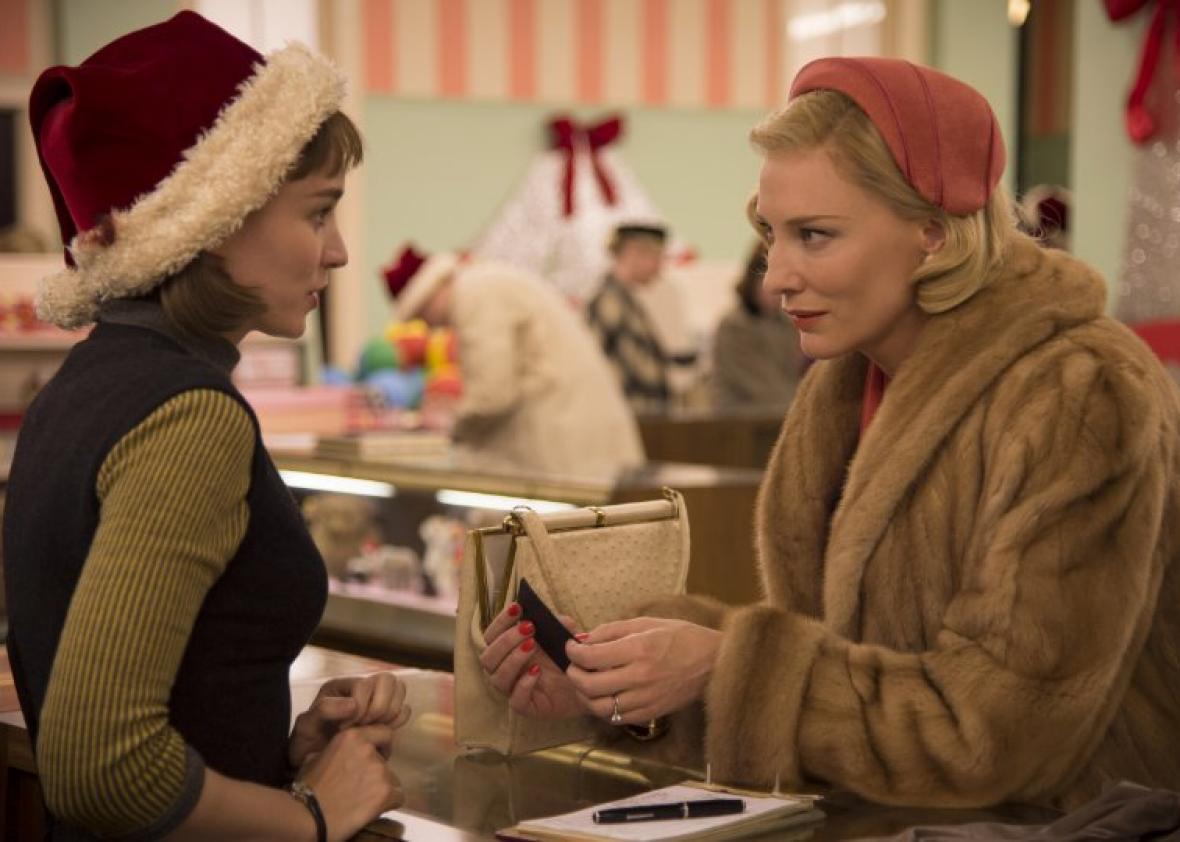Unlike other minorities, gay men and lesbians don’t learn about our culture from our families. Indeed, no one knows we belong to a minority until we figure it out for ourselves and tell them. Traditionally, we’ve gathered information about meeting and mating from schoolyard gossip and furtive encounters, in dorm rooms and out-of-the-way watering holes. These days, thanks to gay-straight alliances, a wealth of literature, and the marvels of the Internet, it’s never been easier to learn how to be gay.
Now that enlightenment is only a click away, it’s easy to forget how terrifying it once was—and still is for many people the world over—to feel those first stirrings of difference, stirrings usually followed by a desperate search for someone to serve as a trusted guide. Todd Haynes’ Carol, the story of two women finding each other in the 1950s, is a beautiful depiction of a young woman’s conflicted desire for an older woman—and of how that older woman slowly leads her down the path of initiation.
The young woman is Therese Belivet (Rooney Mara), an aspiring photographer working the Christmas season at a New York City department store when she meets Mrs. Carol Aird (Cate Blanchett), who is shopping for a gift for her young daughter. The contrast between the two women is severe: Carol is a vision of upper-class status—expensively dressed, confident, and boasting a fancy address outside the city. Therese is the help, forced by store management to wear a dorky Santa hat, so flustered by this particular customer that she almost forgets to charge her. And yet some spark of connection—which begins in the classic manner with a charged moment of eye contact across a crowded room—animates Therese to pursue the older woman.
The details of the pursuit are important, because if this kind of relationship is to avoid seeming predatory, each party is required to actively demonstrate interest. Therese is the one who originates things, noticing that Carol has left her gloves at the sales counter, she remembers her address, packages the gloves, and drops them in a mailbox, with her employee number as the only indication of the sender. Carol, in turn, has to call the store, ask to speak with her good Samaritan, and request another meeting. Therese happily accepts Carol’s invitation to lunch, and though many days and nights will pass before they find themselves in bed together, it feels almost inevitable once each had signaled interest in this cryptic, coded way.
Of course, just because their getting together was inevitable, that doesn’t mean it’s easy. There are endless hurdles, most notably that Therese doesn’t think of herself as a lesbian—at least not yet. She has a boyfriend, albeit one with whom she’s out of sync. And she can’t explain to her friends—or even to herself—why she wants to spend time in the suburbs with a middle-aged mom when she could be hanging in Manhattan with her peers.
Carol does a miraculous job of conveying the irresistible, often confusing force of same-sex attraction that makes itself felt long before there are words to describe it. Young people have often been drawn to older gay men and lesbians in this liminal period, because straight friends and family aren’t just unhelpful when it comes to understanding these queer urges—they’re often downright hostile. In Carol, Therese’s friends are big-city bohemians, as progressive as they came in 1950s America, but they still dismiss her interest in Carol as a perverted impulse or a childish crush. “You’re like a schoolgirl,” Therese’s boyfriend snarls when she prepares to head off to the burbs.
While it’s easy to see why Therese would be so intoxicated by Carol, it’s not so clear what Carol sees in Therese. She’s beautiful, of course, and free of the controlling malevolence of Carol’s estranged husband. But they’re at very different stages in their lives. At their first meal together, Carol glimpses at the menu and immediately knows what she wants—she’s been there before, in more ways than one. Therese is clueless and asks for whatever Carol is having. “I barely even know what to order for lunch,” she says, embarrassed.
We’re never told the age difference between Carol and Therese, but it’s enough to give off a mother-daughter vibe from time to time. Therese has the same hairstyle as Carol’s infant daughter; Therese doesn’t drive, which means Carol always has that responsibility; and their Christmas gifts to each other have the asymmetric quality of an exchange between parents and children. Their affiliation could easily have remained one of vaguely maternal mentor and mentee rather than tumbling into romance, and there would still have been a sort of satisfaction in that. This aspect of Carol and Therese’s relationship reminded of the 1987 film I’ve Heard the Mermaids Singing, in which sweet, naïve Polly is entranced by the refinement of her boss, the curator of an art gallery. Polly loves the curator, who is bi, but the attraction isn’t sexual; she’s just drawn to the way the sophisticated older woman exposes her to worlds she’d never dreamed of.
But Carol and Therese aren’t mother and daughter or just mentor and mentee; there’s a deep sexual attraction between them from the moment they set eyes on one another. Carol feels it, but she resists acting on it—in part because she knows it could cost her custody of her daughter, and in part because the rules of intergenerational relationships require that the younger person make the first move if they’re ever going to have a partnership of equals. When Therese finally whispers, “Take me to bed,” it’s a beautiful, sexy moment in the film, but it’s not the end of Therese’s journey. She still has some growing up to do, some “blossoming” as Carol later describes it. Carol shows that journey toward maturity—and happy homosexuality—better than any movie I’ve ever seen before.
